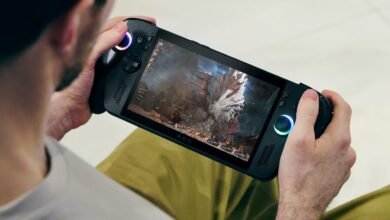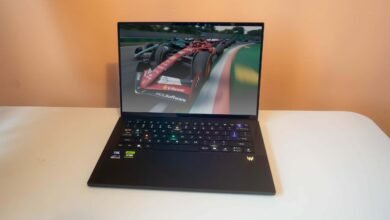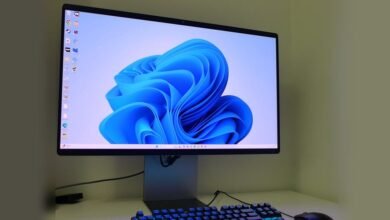Lenovo Legion Go 2 Review: Ryzen Z2 Extreme Shines at 800p

▼ Summary
– The Lenovo Legion Go 2 features the AMD Ryzen Z2 Extreme processor, offering performance improvements particularly at lower resolutions like 1280 x 800p.
– It includes an upgraded 8.8-inch OLED display with vivid colors and deep blacks, though the resolution is lower than the previous model at 1920 x 1200.
– The handheld has detachable controllers with improved ergonomics, Hall effect joysticks to prevent drift, and an FPS mode that allows mouse-like control.
– At 2.03 pounds, it is bulkier and heavier than competitors, and battery life is limited, lasting around 3 hours for demanding games even with reduced settings.
– Priced at $1,349.99 as tested, it is expensive but offers exclusive features like detachable controllers and OLED screen in the Windows handheld market.
The Lenovo Legion Go 2 delivers a significant performance boost at lower resolutions thanks to its powerful AMD Ryzen Z2 Extreme processor, making it an intriguing option for gamers seeking top-tier handheld power. Lenovo has refined the ergonomics and introduced a stunning OLED display, though the device remains notably bulky, heavy, and commands a premium price. For those prioritizing raw hardware capabilities and unique features like detachable controllers, the Legion Go 2 stands out, but its considerable cost and heft mean it won’t suit every portable gaming enthusiast.
Visually, the Lenovo Legion Go 2 is unmistakably a large handheld. Its substantial frame accommodates the removable controllers and likely aids in thermal management. The updated TrueStrike controllers maintain their resemblance to Nintendo Switch Joy-Cons in their detachable, wireless functionality, but the similarities largely end there. These controllers are sizable, yet Lenovo has enhanced their ergonomics with more rounded edges that improve comfort during extended use. They feature a familiar Xbox-style button layout with offset analog sticks. On the back, the left controller houses two buttons, while the right includes one, plus two additional customizable buttons for mouse mode.
Hall effect joysticks are now included to prevent drift, and the D-Pad has been redesigned with a pivot disk. The buttons offer slightly less tactile feedback than ideal, though they become comfortable with use. Beyond the rear buttons, the right controller provides three customizable inputs via Legion Space and retains the mouse sensor for FPS mode, complete with a stand. This mode lets you position the controller vertically in its base, mimicking a mouse for precision aiming.
FPS mode functions as intended, though it didn’t become my primary way to play, since I typically use handhelds away from desks. Utilizing this mode demands considerable button remapping; several games lacked default mappings for certain commands. While you can create numerous profiles, frequent shooter players will need to save and switch between presets regularly.
I found the right control stick’s placement slightly awkward. Though positioned similarly to an Xbox controller, its placement caused my thumb to brush against it during button-heavy games like Tony Hawk’s Pro Skater 3 + 4. Adjusting to the abundance of menu and options buttons also took time. The left controller has four (Legion Space, Xbox-style view, Alt-Tab, and Windows desktop), while the right has two (quick settings and Xbox Menu). I often used the quick settings button, though I missed a dedicated Xbox button for Game Bar.
The right controller includes a touchpad, but there isn’t a matching one on the left. Having dual touchpads, like the Steam Deck, would be preferable. The controllers connect via Pogo pins, sliding into rails and detaching with a button press. Reattachment sometimes proved tricky, occasionally scratching the rail’s paint. A cover is provided for the right rail in FPS mode, though a second cover would be welcome for frequent detached use.
On the top edge, you’ll find a USB4 Type-C port, volume rocker, and a power button that doubles as a fingerprint reader. Additional ports, another USB-C, a 3.5mm headphone jack, and a microSD slot, are on the bottom. This layout conveniently allows simultaneous charging and peripheral connection. The fingerprint reader works well but requires a slight stretch to reach in handheld mode.
RGB lighting circles around the joysticks add customizable flair. These can display colors set in Legion Space or indicate battery status and connection state via blinking patterns. A robust kickstand spans most of the device’s width, ensuring stability. Ventilation slots on the back draw in cool air, pass it over the Ryzen Z2 Extreme, and exhaust it through top vents positioned well away from hand grips.
Measuring 11.64 x 5.38 x 1.66 inches with controllers attached, it’s thicker than the original Go but slightly smaller in other dimensions. It outweighs the original Go (1.88 pounds), Asus ROG Ally X (1.49 pounds), and Steam Deck OLED (1.41 pounds) at 2.03 pounds. The heft is immediately noticeable, sometimes leading to hand and wrist fatigue after longer sessions.
Under the hood, the Legion Go 2 is the first handheld tested with AMD’s Ryzen Z2 Extreme. This 8-core, 16-thread processor combines three Zen 5 cores with five Zen 5c cores. The Zen 5 cores boost up to 5 GHz (Zen 5c cores up to 3.3 GHz), with a base clock of 2 GHz. While its 28W TDP matches its predecessor, the configurable TDP range extends higher at 15-35W. The 16-core RDNA 3.5 GPU represents an upgrade from the Z1 Extreme’s 12 cores.
Our review unit’s 32GB of RAM provides a leg up over competitors like the ROG Ally X with 24GB. Storage is a 1TB M.2 2242 SSD, though the slot supports more common M.2 2280 drives for upgrades. The 74 WHr battery is a major step up from the original’s 49.2 WHr cell, though still slightly smaller than the Ally X’s 80 WHr.
Gaming performance shows clear improvements, especially at 1280 x 800. In Tony Hawk’s Pro Skater at 800p on high settings, frame rates ranged from 73 to 93 FPS. Marvel’s Midnight Suns maintained a solid 60 FPS cap on medium settings with balanced thermals. Shadow of the Tomb Raider hit 66 FPS at 800p unplugged and 75 FPS plugged in. Cyberpunk 2077 using the Steam Deck preset reached 47 FPS unplugged and 57 FPS plugged in. Red Dead Redemption 2 on lowest settings hit 65 FPS unplugged and 80 FPS plugged in. Borderlands 3 on medium settings saw 76 FPS plugged in and 67 FPS unplugged at 800p.
The 8.8-inch OLED display, now 1920 x 1200 instead of 2560 x 1600, is a highlight. It covers 135.8% of DCI-P3 and 191.7% of sRGB color spaces, outperforming rivals, though its 445-nit brightness is dimmer than non-OLED competitors. The glossy screen can be reflective at lower brightness.
Battery life is modest. You can expect roughly three hours for moderately demanding games, less for intensive titles, and more for lighter 2D games.
The 2W stereo speakers on the top edge deliver clear, loud audio, though bass is lacking. Thermal management is effective, keeping CPU and GPU averages at 65.5°C and 62.9°C.
Upgrading the SSD requires careful disassembly, but it supports both M.2 2242 and M.2 2280 drives.
Pricing is steep: $1,349.99 for the Z2 Extreme, 32GB RAM, and 1TB SSD. A cheaper $1,099.99 version offers the base Ryzen Z2, 16GB RAM, and 1TB storage.
The Lenovo Legion Go 2 appeals to gamers wanting the most powerful AMD Z-series chip, an OLED display, and detachable controllers. At $1,349.99, it’s a feature-rich but heavy handheld with limited battery life.
(Source: Tom’s Hardware)




